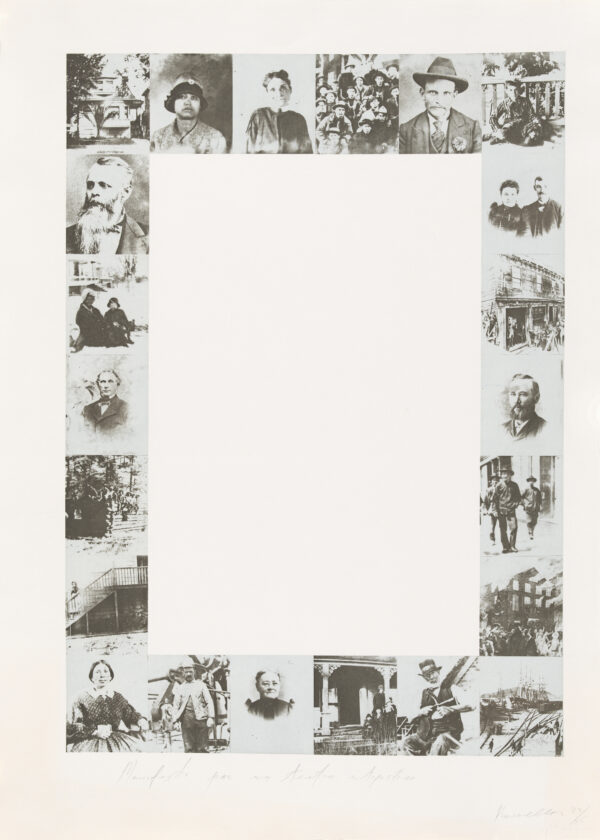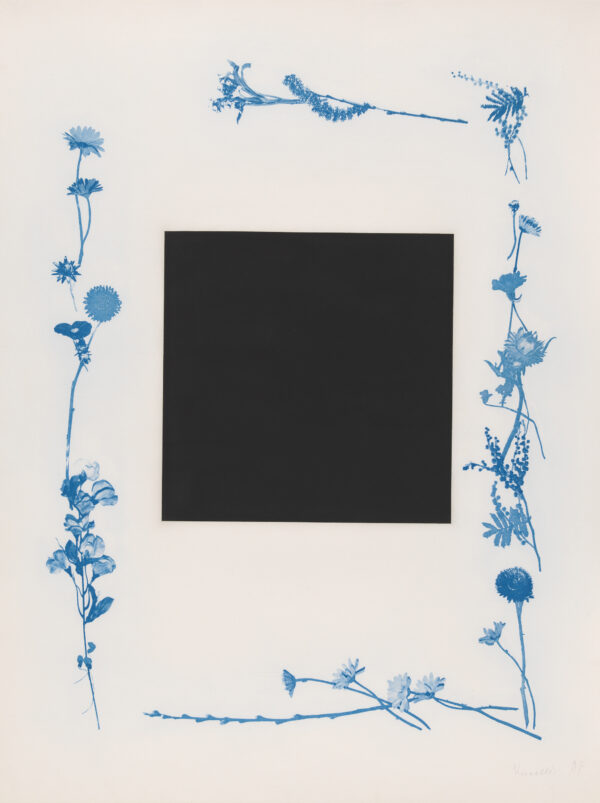Jannis Kounellis (1936-2017) was a member of the Arte Povera movement and a forefather of contemporary installation art. Although his first artworks were abstract paintings, he quickly abandoned the traditional medium of paint on canvas in favor of a wide variety of unconventional materials. He is best known for incorporating the unexpected and surprising into his artworks, which have been comprised of such things as burning fuel, musical performance, heaps of coal, slabs of steel, plaster casts of classical sculptures, and even live animals. The most famous of his installations occurred at the L’Attico Gallery in Rome in 1969. Titled Cavalli, it consisted of twelve live horses tethered around the perimeter of the room inside the gallery (and was restaged at the Gavin Brown Enterprise, New York, in 2015). Art critic Germano Celant called these material choices a response to two other contemporary art movements, consumerist Pop art and rigid Minimalism. Using active, dynamic elements like fire and animals, Celant says, was part of Kounellis’s effort “to convey a sense of continuous transformation in his work…and to maintain the tension that underlines the public credibility of art.”
Despite the vibrant range of objects he used and the three-dimensional space they occupied, Kounellis described his art as painting. “In the last analysis, for me it is painting,” he says. “I am a painter…because painting is the construction of images.” His endeavors to construct images include his artwork, his writing of poetry and prose, and his work as a set designer for the theater. Under directors Carlo Quartucci and Heiner Muller, Kounellis explored non-traditional means of invoking cinematic tones on the stage. His later installations involving action, time, and living beings reveal this influence. For example, a 1969 installation involved Kounellis seated on a chair at a large steel desk. On the desk sat a potted cactus and a nude woman, cross-legged and with her chin resting on her hand. Each element was arranged such that there was a sense of suspended action. In 1975, another installation included the element of costume. The artist presented himself wearing a cast plaster mask and clutching a kerosene lamp while sitting rigidly atop a horse.
The influence of theater on Kounellis extended to the language he used to talk about art. He has called each of his exhibitions “a unique act,” asked the public to “consider that the gallery is a dramatic, theatrical cavity,” and referred to his materials as “props.” This language suggests that Kounellis’s roster of remarkable materials could be voided of their anticipated meanings and bestowed with new ones. Art critic Laura Cumming asserted that Kounellis’s “art requires that viewers be prepared to tune their own sensitivities to the idea that anything and everything can be fraught with meaningfulness.” Noting this in his own writing for Artforum in 1988, Kounellis muses, “Where lies the beauty in a beer can? How does it differ from a painting by Titian?”
His use of unusual materials and his theatrical tendencies are two reasons Kounellis was included with other Italian artists in the Arte Povera movement. The name of the movement, Italian for “poor art,” was invented by Germano Celant in 1967. Celant’s choice of the term “poor” referred to three areas of artistic poverty, all of which are exemplified by elements of Kounellis’s work. First, street theater and anti-elitist protest, considered low or “poor” forms of expression, influenced Kounellis’s creation of installation art. Secondly, humble, ephemeral, and everyday materials, the sort of objects Kounellis continually re-imagined in his artwork, were called “poor” in contrast to traditional, elite, or “high” art materials like marble, cast bronze, and oil paint. Finally, rejecting the institutionalization of art led to “poor” economics. An example is the installation of horses at the L’Attico Gallery. The Tate Modern described this action as an “extreme manifestation of the desire to make art that could not be sold.”
Although canonized as an Italian artist, Kounellis was born in Greece in 1936. After living through World War II and the Greek Civil War, he embraced a new home in Rome at age 20. His first solo exhibition was held in Rome in 1960, when he was still a student, and featured black and white stenciled paintings. By 1967, he was considered a member of the Arte Povera movement and had completed such works as a wall hung with sheets of burlap, an iron platform supporting various cacti, and a live parrot perched on a clothes hanger. A Kounellis retrospective was mounted at the Museum of Contemporary Art, Chicago, in 1986. He has been the subject of solo exhibitions at international museums, including the Museum of Cycladic Art, Athens (2012); Tate Modern, London (2009); the Neue Nationalgalerie, Berlin (2007); the Albertina, Vienna (2005); the Museo Nacional Centro de Arte Reina Sofia, Madrid (1996); the Castello di Rivoli Turin (1988); the Whitechapel Art Gallery, London (1982); and the Stedlijk Van Abbemuseum, Eindhoven (1981). In 2019, the Fondazione Prada (Venice) presented “Jannis Kounellis”. Curated by Germano Celant, it was the first major posthumous retrospective dedicated to the artist. Kounellis lived and worked in Rome, Italy. His estate is represented by Sprovieri in London and Gladstone Gallery in New York and Belgium.
-Christine M. Peterson, Crown Point Press

